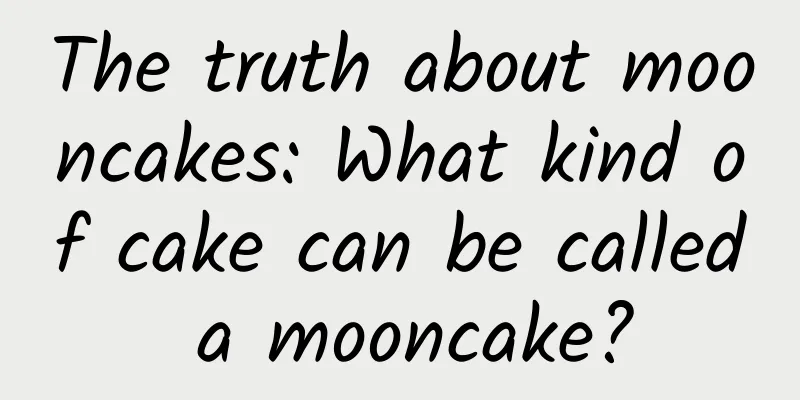|
Written by Wei Shuihua Header Image | Who is the most Chinese? (This article was first published on Guokr.com Foodie Research Institute, and the original text has been edited) Is there a standard that can accurately define mooncakes? Mooncakes made with flour as the skin? What about Taoshan mooncakes? Cakes made using baking techniques? What about snowy mooncakes?
A round cake that looks like the moon? What is this Cantonese-style mooncake?
Vegetarian mooncakes? What about the pepper beef mooncakes and the mustard tuber meat mooncakes? A snack with stuffing? Do Guokui and Mabing count as mooncakes?
Yes, there is no standard for mooncakes. In China, any cake eaten during the Mid-Autumn Festival can be called a "mooncake." It doesn't even matter whether it is a "cake." In many cases, the so-called "mooncake" is actually closer to the Chinese word "cake." In other words, "mooncake" itself has no substantial connection with a certain taste or a certain food. More often than not, it is a concept that is subtly accepted and recognized by most people, just like "nation" and "country."
No.1 The history of mooncakes is not as long as most people imagine. Some say it was a dry food in the Shang Dynasty, while others believe it originated from the Tang Dynasty court. Unfortunately, there is no reliable written evidence for these speculations. Although the word "bing" appeared very early, for a long period of history, the meaning of "bing" was completely different from today's cake. The "Explanation of Names" of the Eastern Han Dynasty said: "餠, 幷也, 麲麵作湷也." In short, the original meaning of bing is wheat dough.
According to the way of eating, boiled cakes are called soup cakes, steamed cakes are called steamed cakes, fried cakes are called oil cakes, and cakes made into strips are called "suo bing". Later, the word "zheng" in steamed cakes was changed to "chu" because it offended the name of Emperor Renzong of Song Dynasty, Zhao Zhen. Yes, it is the thing sold by Wu Dalang in "Jin Ping Mei". Today, we call it "mantou"; and suo bing is another popular food today: noodles.
But it was not until the Tang Dynasty, when people from all over the world came to pay tribute, that something called "Hu Bing" began to appear frequently in literature. The production method is similar to today's sesame cakes. After the dough is pressed into a flat round shape, it is baked to make it crispy. It is generally believed that Hu Bing is the predecessor of countless Chinese sesame cakes, baked cakes, and pancakes. It is called "Hu" because it comes from the diet of the Hu people in the Western Regions. This way of eating did not exist in traditional Chinese cuisine before the Tang Dynasty.
Today, most mooncakes that are baked as the mainstream production method are actually derived from this. In fact, in many cases, Chinese cuisine does show a cooking concept based on steaming and boiling: CHINA, as a synonym for pottery and China, reflects the leading level of the Chinese in the production of ceramic utensils. Before the metallurgical technology was mature, only high-quality ceramics that could withstand heating without cracking could be used for cooking. This is the civilizational basis for Western cuisine to focus on baking and roasting, while Chinese cuisine focuses on steaming and boiling.
Compared with open flame baking, steaming is advanced in many aspects. It can precipitate water-soluble proteins, polysaccharides and other nutrients that are easy to be absorbed by humans in the long cooking process, make fat form fully emulsified small particles, and better maintain the integrity of the taste of food by slowly heating. However, with the advancement of technology, humans have become more and more precise in controlling the temperature of flames, and the original thick ingredients have been greatly improved from being "burnt on the outside and raw on the inside" after baking.
The rise of Chinese barbecue dishes, represented by roast duck, since the Ming Dynasty is a very significant example. The maturity and birth of modern mooncakes with fillings is also an inevitable law under the great trend of technological iteration.
No.2 The true budding of mooncakes may have started in the Song Dynasty. Su Shi's "small cakes are like chewing the moon, with crisp and sweet fillings inside" is certainly popular. In the "Dream of Lianglu" and "Dongjing Menghualu" of the same period, a large number of street snacks named "cakes" began to appear. For agricultural civilizations, grain crops have important survival significance and are indispensable items for sacrifices. And wheat flour, with its excellent plasticity, is kneaded into various shapes together with glutinous rice products, and has contracted most of the props for Chinese sacrifices: spring pancakes, dumplings, wontons, and rice cakes for the Spring Festival; glutinous rice balls and Yuanxiao for the Lantern Festival; scallion pancakes for the second day of the second month; green cakes for Qingming; zongzi, fried dough sticks, and rice cakes for the Dragon Boat Festival; Qiaoguo for the Qixi Festival; flower cakes for the Double Ninth Festival; glutinous rice cakes, glutinous rice cakes, and glutinous rice cakes for the Winter Solstice...
But in the long history when most people struggled to survive for food and clothing, these things were just sacrifices. There was no development of complex cooking techniques, nor was there any motivation to improve the taste. In the Song Dynasty, the original sacrificial items were transformed into street snacks, which in itself is a feature of economic development. And those carefully crafted "cakes" happened to catch up with the dividends of this era and became foods with both sacrificial and edible values.
However, there is no evidence that the "small cakes" described in Su Shi's poems and the snacks in the notes of literati in the Song Dynasty were baked in a similar way to Hu cakes, nor can it prove the correlation between these folk "casual food" and festivals. The cooking method of Su Shi's "small cakes" is more likely to be steamed. Its appearance is more similar to today's sweet buns with maltose filling.
The grassroots Ming regime, in addition to driving out foreigners, also brought about many changes in customs. Foods that had a low social status in the previous dynasty, such as pork, shochu, offal (tripe), and soy milk, all made a comeback and gradually entered the mainstream Chinese dining table.
The changes in eating habits are closely related to the preferences and habits of the top class.
In the context of the highly developed agricultural civilization, the concept of "family rule" finally matured during this period. Before the Song Dynasty, the sentiments of literati and scholars looking at the moon and thinking of their hometowns during the Mid-Autumn Festival further interpreted the customs of worshiping the moon and reuniting with their families among the people. Due to the dual needs of sacrifice and sharing, people have higher requirements for the appearance of moon cakes. Objectively speaking, boiling and steaming will inevitably cause damage, softening and swelling on the surface of the dough. But if baking is used, the surface of the dough can be dehydrated and colored, resulting in a more complete and controllable appearance. Baking, as the main means of making moon cakes, was not completely fixed until the middle of the Ming Dynasty at the latest.
No.3 Oil is the most important supporting role in mooncake making in the modern sense. It made its debut in this historical period. After fully mixing it with flour and baking it, you can get a fermentation-like effect, which is porous, loose, crispy, and similar to biscuits or cakes. People wrap the fillings with this oil skin. This is the most traditional and extensive pastry method, which is only retained in very few areas with inconvenient land transportation in ancient times, such as Quzhou and Wenzhou in Zhejiang, Minhou in Fujian, etc. The most famous of them is the Yunnan leg mooncake. From the origin of mooncakes, these oil-flavored mooncakes may be the oldest relics in today's mooncake pedigree.
In the late Ming Dynasty, the Age of Exploration began. The Portuguese and Dutch brought European Thousand Layer Cake technology from afar. Records of this kind of food appeared in Quanzhou and Guangzhou, which were coastal trading areas. Perhaps inspired by this, people improved the mooncake skin technology, and the oil and water skins were complicatedly overlapped and rolled. After baking, they got layers of puff pastry, which would fall off when touched and melt into crumbs when bitten. Because it is not easy to transport over long distances and is easy to deteriorate, this kind of shortbread is often limited to a certain area. After encountering local specialty fillings, its name became Su-style mooncake, Anhui-style mooncake, Qin-style mooncake, Ningbo mooncake, Chaoshan glutinous cake... In fact, except for the choice of fillings and some production details, they are all born of the same mother.
The third type is to add syrup and alkali to the oil-skin cake mentioned above. Syrup can color the crust, giving the finished product a beautiful brown-red color after baking, and prolonging the shelf life. Alkali can modify the protein (gluten) in the flour, while obtaining a soft taste, strengthening the gluten, making the crust thinner and carrying more fillings. In essence, this is the same logic of processing ingredients as adding ash to Lanzhou beef noodles and adding alkali to Chaoshan crispy noodles. But the crispy crust used for mooncakes is an epoch-making innovation. The cakes made in this way can often reach a skin-filling ratio of 1 to 5, or even higher. This is unattainable for other types of mooncakes. It is worth emphasizing that because of the large amount of fillings, thick body, and soft taste, strictly speaking, it is actually not a "cake" with a flat and crispy taste in the popular sense, but a "cake".
In the notes of the late Qing Dynasty, "Yanjing Sui Shi Ji", it is interestingly recorded that "moon cakes are available everywhere. The big ones are more than a foot in size, with the shape of a toad painted on them. Some people eat them after the sacrifice, while others save them for New Year's Eve." Obviously, only with alkali skin can moon cakes of "more than a foot" in size be made and remain intact after being removed from the mold. It can be seen that alkali skin was already very popular at that time.
Today, alkali mooncakes have another more widely known name - Cantonese mooncakes. In fact, "Cantonese" does not refer to Guangzhou alone. Most mooncakes produced in various places through standardized production are made based on alkali skin. Its name may reflect the history of Guangzhou leading the opening of ports in the Qing Dynasty and being the first to contact and introduce Western baked pastries; or it may explain the mutual tolerance between Cantonese dim sum and alkali mooncakes. Although the controversy over the taste of various mooncakes has never stopped, because of their online appearance, easy transportation, and natural preservation, by the middle of the Republic of China at the latest, Cantonese mooncakes had already become the standard image of Chinese mooncakes. This is a respect for technological progress, and it is also the character and quality of the Chinese people who are good at objectively examining the rise and fall of the times.
No.4
After the 1990s, due to the maturity of cold chain technology, preservation after long-distance transportation is no longer an obstacle. Based on the shape and texture of Cantonese alkaline mooncakes, the Chinese have many new ideas. For example, Taiwanese people used the "Momoyama skin" from Japanese wagashi and filled it with traditional Taiwanese egg yolk pastry fillings to invent Taiwanese Momoyama skin mooncakes. Momoyama skin is a delicate and soft pastry made from white kidney bean paste mixed with milk and cream to replace flour skin. Although the shortcomings of Momoyama skin are obvious: it is not collision-resistant and easy to deteriorate, in order to obtain a softer taste, this kind of thing that can be solved by spending more money is not a problem.
Another example is the snowy mooncakes that have become popular in recent years. In order to create a crystal-clear effect, konjac starch is often used as the skin to wrap the colorful fillings. The low-temperature freezing solidifies the soft taro starch skin, giving it a coating effect similar to that of alkali skin. Similarly, there are frozen black and white chocolate skins.
At the same time, due to the maturity of the logistics network, pastry mooncakes from various places that were not suitable for long-distance transportation in the past, such as Suzhou's fresh meat mooncakes, Yunnan's flower cakes and ham cakes, and Chaoshan's glutinous rice cakes, have all left their hometowns and entered the increasingly larger world. Whether it is the new mooncakes invented by people or the "old wine" in new bottles in various places, they all prove the endless imagination of the Chinese when facing food, and the mooncakes themselves, the eclectic characteristics of Chinese cuisine. Its thousand-year tortuous journey expresses the ultimate fun of Chinese dim sum, which can be used for banquets in temples and in the lives of ordinary people.
|










![[Ten thousand words of heavy and in-depth] The strange current situation of the smart TV industry witnessed in the past ten years](/upload/images/67f0a96364895.webp)